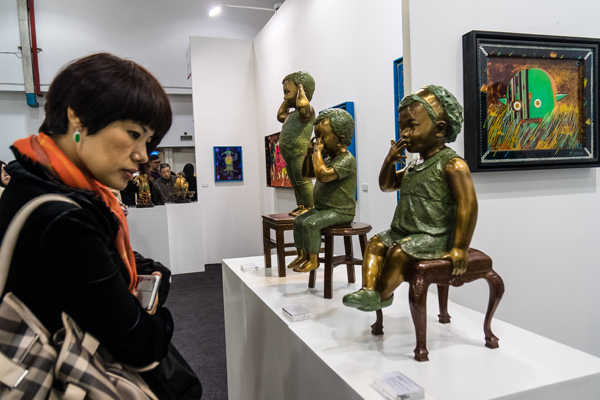 |
|
A visitor looks at artworks at the Shanghai Art Fair held in Shanghai, Nov 13, 2015. [Photo/VCG] |
China's artworks have experienced a distinct decline as investors, low on confidence, turned cautious. "The business model that relied on high growth of traditional resources and significant appreciation of art assets in a short time has ended. The artwork market should seek some emerging business opportunities. It should meet the demand for contemporary aesthetics," Ren said.
Experts said in the long term, art consumption is likely to support the transformation and structural adjustment of Chinese artwork market that has been collection- and investment-oriented.
The market is also expected to get a mass dimension. Deals at art galleries, expositions and other primary markets will likely become major growth engines.
"The growth potential in art consumption has been directly reflected by the turnover at the Shanghai Art Fair last year," said Wu Fang, art director at Shanghai-based Huafu Art Space.
"The total turnover at the fair reached 141 million yuan, and the income mainly came from transactions for low-cost consumer art, with most of them priced at several thousand yuan to 30,000 yuan.
"Art consumption is expected to draw more attention, and the content and style of artworks are likely to become more modern. The methods of creating artworks and the structure of the market should also be transformed to adapt to a brand new era."
Artwork auctioneers and art collection agencies said there has been an obvious decline in auctions of traditional goods. At the same time, they saw an increase in online art consumption, with buyers being increasingly younger.
As a result of continuous expansion of the auction industry in recent years, a lot of artworks have been auctioned repeatedly. There has been a serious demand-supply imbalance in auctioned goods. Consequently, it is now difficult to find top-level artworks.
Among artworks and other precious products, those that suffered the most were neither affordable or cheap consumer arts nor rare high-end fine arts, but medium-range ordinary artworks that anyway have limited investment value.
Even among high-end collections, some segments like green tea and rosewood furniture did suffer. For example, not very long ago, some art collections and fine goods commanded extremely high prices. But they, too, came under pressure when the government's austerity drive dampened demand.
Many premium tea brands saw a constant slide in their prices. A type of the finest Pu'er by Chinese tea brand Dayi, a top-class green tea, saw its price drop from 24,000 yuan to 10,000 yuan per kg.
